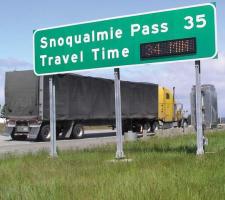
David Crawford looks at a US model which, for modest federal funding, is producing substantive results.
Outward and upward is the clear message emerging from the US$458,000, 2015 workplan of the US government’s ENTERPRISE (Evaluating New TEchnologies for Roads PRogram Initiatives in Safety and Efficiency) joint funding scheme for ITS research.
ENTERPRISE is a transportation pooled fund (TPF) initiative set up by the US DOT’s Federal Highway Administration to coordinate and contribute to US state and local agency efforts. Its US$475,000 budget for 2015 comes from annual and project contributions by member agencies - 11 state DOTs and the Ministry of Transportation in Ontario, Canada (one of two non-US participants, the other being The Netherlands). These are the primary source of project proposals and voting for the ones they want to see carried out.
Criteria for acceptance of a TPF proposal is that the project tackles a new area of research or technological innovation; or to deliver fresh information or additional experience to fill gaps in, or further advance, previous work (see below). Partners must show that they consider issues important enough to pledge their own funds; and that there is substantial interest in producing a relevant solution.
US state DOTs can make their own contributions using federally-derived state planning and research funds. These derive from a mandatory 2% of each state’s total apportionment of dollars under relevant programmes from the Highway Trust Fund, the US’ fuel tax-fed national resource for financing highway and other transportation funding.
Of the 2% set aside, a minimum of 25% must be spent on state planning and research. State planning and research sources typically cover at least 20% of the funding required, while the federal contribution is limited to a maximum of 80%.
Member states have the option of bringing in commercial partners. In encouraging the creation of public-private partnerships, the scheme uses criteria originally developed to support Minnesota’s Guidestar programme.
Projects now getting under way with state departments of transportation, supported by ENTERPRISE’s coordinating role and financial contributions, cover topical concerns including cross-border ITS and drone deployment.
The ‘Use of unmanned aerial vehicles for road incident reporting’ initiative aims to leverage growing interest in drone technology for incident detection, emergency response coordination, road condition reporting and remote highway monitoring. It is being supported by an ENTERPRISE contribution of US$50,000.
It will build on a Michigan state DOT project that is already researching the potential role of unmanned aerial vehicles for road and bridge monitoring. In September 2014, the Michigan Tech Research Institute flew drones for the benefit of delegates to the ITS World Congress in Detroit.
Meanwhile, the Ministry of Transportation in Ontario, Canada is currently using drones to film traffic accident sites for future analysis.
The ‘ITS at international borders’ project (ENTERPRISE funding US$80,000) addresses the fact that six US member state agencies have highway networks that connect with those in Canada or Mexico. The key need they have identified is for timely and accurate information on border waiting times and security alerts, as well as on construction works under way on the other side of the border.
ENTERPRISE approvingly cites member Washington State DOT’s travel information website’s ‘Traffic at the Canadian border’ page, experience from which will be shared at a dedicated project workshop.
Other 2015 projects will research best practice in truck rollover warning systems, aided by a US$60,000 ENTERPRISE contribution, and the policy and legal aspects of using and sharing fibre-optic infrastructures in ITS deployment to which ENTERPRISE is contributing US$35,000. A further two are focussing on the role of dynamic message signs (DMS) in advanced travel information systems.
The first of these is receiving an ENTERPRISE contribution of US$80,000 for exploring the integration of active highway work zone notifications displayed on portable DMS into the permanent DMS network. It is piloting a method for in-field devices such as portable DMS to transmit their locational and message displayed data to a reporting centre without the need for manual intervention. ENTERPRISE member agencies will be closely involved in developing the necessary engineering documentation.
The second project is looking at using portable travel time displays to optimise the deployment of permanent DMS installations used for integrated corridor management. While state DOTs have found DMS are effective in alerting drivers to expected delays ahead, the siting of the signs has not always been adequately researched. Their usefulness can be heavily influenced by, for example, the availability of alternative routes and general traffic patterns. As the ENTERPRISE workplan points out: ‘DOTs could invest considerable funding at one location only to find that the impact on travel delays is not recognised.’
Therefore the project is investigating the development of portable kits that will enable DOTs to ‘test the market’ with possible DMS sites before committing themselves to investing in permanent installations. The kit, which the project intends to demonstrate in the field with up to three member DOTs, will consist of Bluetooth sensors, relocatable DMS, communications links and data processing capability – all owned by the DOTs or leased externally. The cost of the pre-deployment phase is US$50,000, contributed by ENTERPRISE.
This second initiative follows on from a project to measure the effects of DMS on driver behaviour. A survey of motorists in the US states of Minnesota and Washington, carried out by Oregon-based
In Minnesota, 42.2% had changed their travel plans on their most recent trip following information shown on the DMS; while 18% kept to their original route. The corresponding figures for Seattle were 22% and 20%.
The study also found wide variations in the length of the delay that prompted diversions. Minnesotans indicated a range of between five and ten minutes extra driving; for their counterparts in Seattle, it needed to be between 15 and 20 minutes.
Issues such as these have prompted the current project. Athey Creek president Dean Deeter told ITS International: “Our findings gave a first indication of drivers’ reactions to travel information messages. These give traffic management centres opportunities to predict route changes when DMS are indicating longer than usual journey times.
“Centre controllers can then, for instance, alter signal timings on the alternative route to accommodate the increased numbers of vehicles that are leaving main highways and display additional ‘wayfinding’ messages along the advised routes. Our research also offers a glimpse of the predictability and impacts of crossing travel time diversion thresholds in the era of connected vehicles and personalised information delivery.”
In Washington State, state ITS operations engineer Bill Legg - who also chairs the ENTERPRISE programme nationally - told ITS International: “The study gave important confirmation that providing travel times is useful to motorists and helps them make more informed decisions. We continue to deploy additional travel time DMS on key commuter routes as part of a larger congestion management effort.”
Another project, for Canada’s MTO, has looked at the role of video analytics as a tool for traffic operations centres in data collection. A further study, with the states of Minnesota and Idaho as partici-pants and California-based
Cogenia technical partner Scott Andrews told ITS International: “Our solution depends on availability. We suggested an initial deployment with smartphones, since those are widely in use and equipped to support cellular and Wi-Fi communications.”
The core idea is that, when the smartphone is within cellular connectivity, it will collect information about the road network ahead, between its current location and the known next connectivity region. This data might be weather- or road-related - some collected from vehicles that have recently passed through and cache it for sending to a traffic management centre once they re-enter connectivity.
“We have supplemented this cellular delivery with, initially, WiFi, and, as available, dedicated short-range communications, at points such as rest areas and intersections,” said Andrews. “We have now identified a range of potential applications that could be implemented using the resulting model, developed these into a system design and proposed a deployment strategy.”














